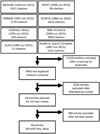Persistence of atopic dermatitis (AD): A systematic review and meta-analysis
- PMID: 27544489
- PMCID: PMC5216177
- DOI: 10.1016/j.jaad.2016.05.028
Persistence of atopic dermatitis (AD): A systematic review and meta-analysis
Abstract
Background: Previous studies found conflicting results about whether childhood atopic dermatitis (AD) persists into adulthood.
Objective: We sought to determine persistence rates and clinical factors associated with prolonged AD.
Methods: A systematic review was performed in MEDLINE, EMBASE, Scopus, GREAT, LILACS, Web of Science, Academic Search Complete, and Cochrane Library. Meta-analysis was performed using Kaplan-Meier plots and random-effects proportional hazards regression.
Results: In total, 45 studies including 110,651 subjects spanning 434,992 patient-years from 15 countries were included. In pooled analysis, 80% of childhood AD did not persist by 8 years and less than 5% persisted by 20 years after diagnosis (mean ± SE: 6.1 ± 0.02 years). Children with AD that persisted already for more than 10 years (8.3 ± 0.08 years) had longer persistence than those with 3 (3.2 ± 0.02 years) or 5 (6.8 ± 0.06 years) years of persistence. Children who developed AD by age 2 years had less persistent disease (P < .0001). Persistence was greater in studies using patient-/caregiver-assessed versus physician-assessed outcomes, female versus male patients (P ≤ .0006), but not in those with sensitivity to allergens (P = .90). Three studies found prolonged persistence with more severe AD.
Limitations: Some studies did not capture recurrences later in life.
Conclusions: Most childhood AD remitted by adulthood. However, children with already persistent disease, later onset, and/or more severe disease have increased persistence.
Keywords: atopic dermatitis; eczema; epidemiology; persistence; prognosis.
Copyright © 2016 American Academy of Dermatology, Inc. Published by Elsevier Inc. All rights reserved.
Conflict of interest statement
Conflicts of Interest: None declared.
Figures


Comment in
-
Conclusions about atopic dermatitis persistence might be premature.J Am Acad Dermatol. 2017 May;76(5):e177-e178. doi: 10.1016/j.jaad.2016.11.067. J Am Acad Dermatol. 2017. PMID: 28411793 No abstract available.
-
Heterogeneity of data included in meta-analysis on persistence of atopic dermatitis changes interpretation.J Am Acad Dermatol. 2017 May;76(5):e181. doi: 10.1016/j.jaad.2016.11.068. J Am Acad Dermatol. 2017. PMID: 28411795 No abstract available.
References
-
- Fukuzumi T, Kobayashi E, Aoki T, Sasai Y, Kanamori S, Yamada I. The influence of ageing and seasons on infantile eczema - a population-based cohort study of babies aged 4 months and 10 months [in Japanese] Arerugi. 2005;54:455–463. - PubMed
-
- Sangsupawanich P, Chongsuvivatwong V, Mo-Suwan L, Choprapawon C. Relationship between atopic dermatitis and wheeze in the first year of life: analysis of a prospective cohort of Thai children. J Investig Allergol Clin Immunol. 2007;17:292–296. - PubMed
-
- Morales E, Garcia-Esteban R, Guxens M, et al. Effects of prolonged breastfeeding and colostrum fatty acids on allergic manifestations and infections in infancy. Clin Exp Allergy. 2012;42:918–928. - PubMed
Publication types
MeSH terms
Substances
Grants and funding
LinkOut - more resources
Full Text Sources
Other Literature Sources

